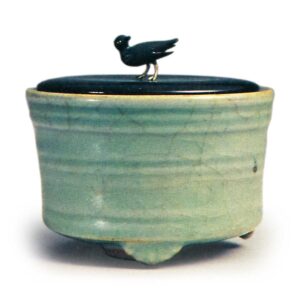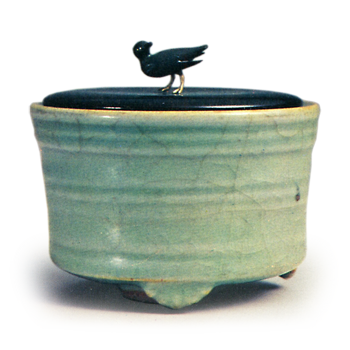
A great masterpiece. A celadon incense burner. The “Gan-kan Meibutsu-ki” (Records of Curiosities and Meibutsu) states, “There are two celadon incense burners with chidori, one for Mr. Owari and one for Mr. Hori Misaku-dono,” and the “Kokin Meibutsu Ruju” also lists two of them, and states that the one owned by the Marquis Owari was originally owned by Shao-oh. According to Matsuyama Ginshoan, the one formerly owned by the Hori family was later handed down to the Kato Shoji family. There is also a Chidori incense burner in the imperial collection, which was once displayed at the Imperial (National) Museum in Kyoto, and was also exhibited at the exhibition of Japanese masterpieces at Ueno, Tokyo, in the spring of 1929. It was exhibited at the Kyoto Imperial (National) Museum, and was also shown at the exhibition of Japanese masterpieces at Ueno, Tokyo, in the spring of 1929. The Yongshu Fushi (Yongshu Prefecture Records) states, “When Oda Nobunaga, the feudal lords and other dignitaries of the capital, came to the capital to make arrangements, Imagawa Ujimasa also came and presented a celadon incense burner with chidori (a bird of prey), which was the rare possession of Sogi Hoshi. The name “Chidori” was taken from the meaning of an ancient poem and given this name. The name “Chidori” is derived from the meaning of the ancient poem “Chidori”. According to the “Shakuji-sha-sou” and “Hosokawa sanzai chasho”, Ujisato Gamo visited Yusai on a bright moonlit night and begged to see the incense burner of the chidori. Ujisato asked Satomura Shaoboe why Yusai looked unhappy at that time, and Shaoboe replied, “Yusai is a true poet. A poem by Juntokuin says, “The moon’s shadows on the waves of the Kiyomi Lagoon are like plovers,” so Yusai was probably unhappy because he thought that plovers were not appropriate on a bright moonlit night. It is not known whether the chidori belonging to Ujizane and the one belonging to Yusai were the same foreign objects, or whether they were passed from Yusai to the Imagawa family. According to the “Ichii Zasshu (Miscellaneous Talks on the City),” “Chidori no Korou (incense burner),” which was an important piece of the Imagawa family in Sunshu, fell into Ujizane’s hands and was given to Oda Nobunaga, but after Nobunaga died it entered Hideyoshi’s hands and is a masterpiece under heaven. The “Taiko-ki” (Records of the Hideyoshi Toyotomi Hideyoshi) also mentions a popular belief that this incense burner was called “Chidori” (meaning “plover”) because it rang when Goemon Ishikawa sneaked into the Taikoh’s bedroom by ninja techniques. It is also said that this incense burner was given to Sengoku Gonpei, who captured Goemon.
The “Ruiju Meibutsu Kou” (A Collection of Famous Articles) states that during the Keicho period (1596-1615), a certain person went out on a snowy night to listen to chidori on the Kamogawa River. Some people have attributed this person to Ashikaga Yoshimasa, and have suggested that chidori like incense and gather together, or that this incense burner was a hand-roasting device used by people listening to chidori to ward off the cold and was meant to be a fire-catching incense burner. Others say that the name is derived from the low beak and legs of the censer. However, as stated in the “Enbekikenki,” the most plausible theory is that it is called “chidorite” because the legs are slightly raised so that a sheet of paper can pass through. According to “Senshinroku,” Sen no Rikyu looked at a newly acquired celadon incense burner, and agreeing with his wife Soen, decided to cut off one minute of the uneven legs, which resembled staggered legs, and gave it the name “Chidori-no-koro” (incense burner with staggered legs).



